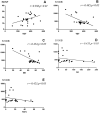Astroglial Mechanisms Underlying Chronic Insomnia Disorder: A Clinical Study
- PMID: 33117005
- PMCID: PMC7549496
- DOI: 10.2147/NSS.S263528
Astroglial Mechanisms Underlying Chronic Insomnia Disorder: A Clinical Study
Abstract
Purpose: The objective of this study was to investigate whether the serum biomarkers S100 calcium binding protein B (S100B), glial fibrillary acidic protein (GFAP), brain-derived neurotrophic factor (BDNF), and glial cell line-derived neurotrophic factor (GDNF) change in patients with chronic insomnia disorder (CID), and if this is the case, whether the altered levels of these serum biomarkers are associated with poor sleep quality and cognitive decline in CID.
Patients and methods: Fifty-seven CID outpatients constituted the CID group; thirty healthy controls (HC) were also enrolled. Questionnaires, polysomnography, Chinese-Beijing Version of Montreal Cognitive Assessment (MoCA-C) and Nine Box Maze Test (NBMT) were used to assess their sleep and neuropsychological function. Serum S100B, GFAP, BDNF, and GDNF were evaluated using enzyme-linked immunosorbent assay.
Results: The CID group had higher levels of S100B and GFAP and lower levels of BDNF and GDNF than the HC group. Spearman correlation analysis revealed that poor sleep quality, assessed by subjective and objective measures, was positively correlated with S100B level and negatively correlated with BDNF level. GFAP level correlated positively with poor subjective sleep quality. Moreover, S100B and GFAP levels correlated negatively with general cognitive function assessed using MoCA-C. GFAP level correlated positively with poor spatial working memory (SWM) in the NBMT; BDNF level was linked to poor SWM and object recognition memory (ORcM) in the NBMT. However, principal component analysis revealed that serum S100B level was positively linked to the errors in object working memories, BDNF and GDNF concentrations were negatively linked with errors in ORcM, and GFAP concentration was positively correlated with the errors in the SWM and spatial reference memories.
Conclusion: Serum S100B, GFAP, BDNF, and GDNF levels were altered in patients with CID, indicating astrocyte damage, and were associated with insomnia severity or/and cognitive dysfunction.
Keywords: S100 calcium binding protein B; brain-derived neurotrophic factor; cognition; glial cell line-derived neurotrophic factor; glial fibrillary acidic protein.
© 2020 Zhang et al.
Conflict of interest statement
The authors have indicated no conflicts of interest for this work.
Figures
Similar articles
-
Patients with chronic insomnia disorder have increased serum levels of neurofilaments, neuron-specific enolase and S100B: does organic brain damage exist?Sleep Med. 2018 Aug;48:163-171. doi: 10.1016/j.sleep.2017.12.012. Epub 2018 Feb 13. Sleep Med. 2018. PMID: 29957487
-
S100B protein, brain-derived neurotrophic factor, and glial cell line-derived neurotrophic factor in human milk.PLoS One. 2011;6(6):e21663. doi: 10.1371/journal.pone.0021663. Epub 2011 Jun 27. PLoS One. 2011. PMID: 21738758 Free PMC article.
-
Aquaporin-4, Connexin-30, and Connexin-43 as Biomarkers for Decreased Objective Sleep Quality and/or Cognition Dysfunction in Patients With Chronic Insomnia Disorder.Front Psychiatry. 2022 Mar 25;13:856867. doi: 10.3389/fpsyt.2022.856867. eCollection 2022. Front Psychiatry. 2022. PMID: 35401278 Free PMC article.
-
Are Anti-Inflammatory Cytokines Associated with Cognitive Impairment in Patients with Insomnia Comorbid with Depression? A Pilot Study.Nat Sci Sleep. 2021 Jun 29;13:989-1000. doi: 10.2147/NSS.S312272. eCollection 2021. Nat Sci Sleep. 2021. PMID: 34234602 Free PMC article.
-
Current Trends in Stroke Biomarkers: The Prognostic Role of S100 Calcium-Binding Protein B and Glial Fibrillary Acidic Protein.Life (Basel). 2024 Oct 1;14(10):1247. doi: 10.3390/life14101247. Life (Basel). 2024. PMID: 39459548 Free PMC article. Review.
Cited by
-
Investigating the Role of BDNF in Insomnia: Current Insights.Nat Sci Sleep. 2023 Dec 7;15:1045-1060. doi: 10.2147/NSS.S401271. eCollection 2023. Nat Sci Sleep. 2023. PMID: 38090631 Free PMC article. Review.
-
MCU knockdown in hippocampal neurons improves memory performance of an Alzheimer's disease mouse model.Acta Biochim Biophys Sin (Shanghai). 2022 Oct 25;54(10):1528-1539. doi: 10.3724/abbs.2022138. Acta Biochim Biophys Sin (Shanghai). 2022. PMID: 36239352 Free PMC article.
-
Relationship between BDNF content in cord blood and early neurobehavior in newborns with subclinical hypothyroidism during pregnancy: a preliminary study.Front Neurol. 2025 Jan 7;15:1465715. doi: 10.3389/fneur.2024.1465715. eCollection 2024. Front Neurol. 2025. PMID: 39839860 Free PMC article.
-
Gender-and age-specific associations of sleep duration and quality with cognitive impairment in community-dwelling older adults in Anhui Province, China.Front Public Health. 2024 Jan 5;11:1047025. doi: 10.3389/fpubh.2023.1047025. eCollection 2023. Front Public Health. 2024. PMID: 38249381 Free PMC article.
-
Insomnia in Forensic Detainees: Is Salience Network the Common Pathway for Sleep, Neuropsychiatric, and Neurodegenerative Disorders?J Clin Med. 2024 Mar 15;13(6):1691. doi: 10.3390/jcm13061691. J Clin Med. 2024. PMID: 38541916 Free PMC article. Review.
References
LinkOut - more resources
Full Text Sources
Miscellaneous



